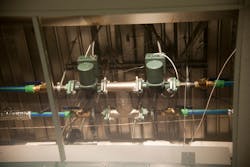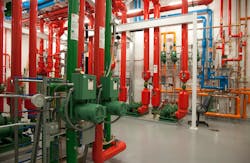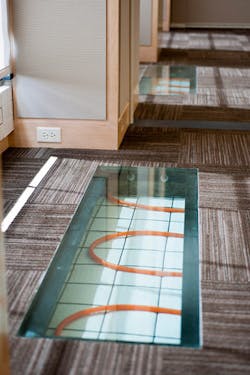Training Center Showcases Integration, Control of Hydronic, Air Systems
In June 2012, Taco Inc., manufacturer of heating and cooling equipment, systems, and accessories for use in hydronic-based applications, opened the Taco Innovation & Development Center, a two-story, 24,037-sq-ft addition to its headquarters in Cranston, R.I.
Featuring classrooms, conference rooms, a business center, and functional laboratories, the Innovation & Development Center serves as a showcase for energy-saving and sustainable products and systems, which are visible throughout the facility for close-up viewing, hands-on learning, and teaching.
Mechanical systems in place in the Innovation & Development Center include chilled beam (active and passive), radiant-ceiling heating and cooling, fan coil, water-source heat pump, perimeter radiation, radiant-floor heating, solar hot water, snow melt, and geothermal. All are controlled with Taco’s iWorx Web-based building-management product line and monitored by a host of sensors and meters throughout the building.
With so much complex equipment being utilized, the entire design-build team was engaged from the start of the project. By thinking in terms of microenvironments, the design-build team was better able to integrate all of the different systems.
Chilled Beams and Controls
Taco wanted to demonstrate the ability of iWorx to manage multiple systems in meeting the needs of not only individual spaces, but the building as a whole. Central to the company’s cooling/heating strategy is the use of active chilled beams.
Taco’s LOFlo injection mixing system functions with active chilled beams. Unlike a conventional system with two sets of pipe, LOFlo uses only one pipe to carry water to a chilled beam. Taco LoadMatch circulators mix low-temperature water of approximately 40°F with circulating water, raising the temperature of the water to 52°F to 55°F, ensuring it remains above the dew point. Only one main circulating pipe for cooling and one main circulating pipe for heating, as opposed to two for each, are used.
Prior to construction, Taco created a test room featuring all of the systems to be used in the addition. Room parameters, temperatures, relative humidity, amount of outside air, and amount of water being circulated are monitored continuously. Data are analyzed for the purpose of updating the iWorx chilled-beam controller’s software.
Compatible with Tridium’s NiagaraAX framework, iWorx is a modular system, which means there is a specially designed controller for each type of equipment. Controllers are linked via low-voltage, twisted-pair wiring to a front-end LCI unit, which is accessible via the Internet. Because iWorx is preprogrammed, it is simple to install and use—all controllers are menu-driven, and basic temperature parameters can be set and changed as needed.
Classrooms, Mechanical Room
Each classroom in the Innovation & Development Center has its own temperature and humidity sensor and carbon-dioxide (CO2) sensor. What makes the system unique is the ability to vary the primary air required by the active chilled beams. This is done as a function of space temperature (or load) and CO2, so demand ventilation can be provided on a room-to-room basis on the second floor. Upon a rise in relative humidity, a signal is sent to an energy-recovery unit to dry the air.
At 1,800 sq ft, the mechanical room is the building’s largest demonstration and teaching space. Taco uses a pre-existing heat plant consisting of five condensing boilers to pump approximately 3 million Btu to the mechanical room for heating and snowmelt. Inside the mechanical room, many of the systems are color-coded for easy identification. Along a wide pathway through the room, Taco showcases how its products functionally integrate into various operating systems.
The high-efficiency McQuay chiller has multiple stages with a significant turndown ratio of approximately 25 percent of full capacity. The chiller is coupled with Taco pumps, which come with integrated variable-speed drives to reduce energy use and match water flow. An existing geothermal system provides a source of heat rejection and heat absorption for the heat pumps serving the main building and those serving the Innovation & Development Center.
For heating- and cooling-load calculation, the design team utilized Taco’s Load Tool software. Load Tool allows separation of cooling load into sensible- and latent-heating categories, enabling removal of sensible heat using a hydronic system (in this case, the active chilled beam) and latent heat using an air system. As a result, the Innovation & Development Center’s air system is about one-third the size of a conventional all-air system.
For system design, Taco’s Hydronic System Solution (HSS) tool was used. With HSS, the building’s piping system was laid out, and the LoadMatch circulators and LOFlo mixing blocks were incorporated.
Energy Efficiency
The design goal was to optimize hydronic-side design and remove/add as much heat as possible using active and passive chilled beams, flat-panel radiation along the walls, and radiant-floor systems.
A McQuay energy-recovery unit delivers air to the active chilled beams for ventilation. The McQuay unit recovers about 70 percent of the energy that is exhausted from the building. During summer, air in the building is approximately 72°F at all times. Rather than that air being dumped outside and fresh air being brought in, the energy-recovery unit recovers some of the heat and even some of the cooling, accomplishing two things: It saves energy by introducing cooler air to the cooling coil and removes moisture from the air. The energy-recovery unit gets its reheat from condenser water rejected by the water-cooled chiller, which further increases energy efficiency.
The mechanical room also contains a multistage chiller with six scroll-type compressors from McQuay. The chiller matches the cooling load by staging the compressors on and off, maintaining the temperature of the chilled water being delivered to the chilled-beam system. The primary chilled water circulating through the building is varied via variable-speed pumps. The chiller rejects heat to the condenser-water system. The cooling tower utilizes variable-speed fans.
Upgrading the Existing Building
While constructing the Innovation & Development Center, Taco took the opportunity to upgrade the mechanical system serving office areas in the existing building. In the renovated spaces are chilled beams, a fan-coil system, and water-source heat pumps. More so than anywhere else across the project, multiple systems of different classifications working in combination are on display. For example, the fan-coil system runs off of the single pipe that feeds the active chilled beams for individual offices. A LOFlo mixing block and LoadMatch pumps deliver both hot and chilled water at precisely the needed temperature. Ventilation air for most of the fan-coil system comes from the energy-recovery unit that provides air to the active chilled beams, and that airflow is varied as a function of demand ventilation.
A unique feature of the project is that a single air source powers the active chilled beams and provides ventilation for the fan coils and water-source heat pumps. (Most buildings would use two or three different types of air systems to support different terminal devices.) This reduces the number of components needed and makes the system much more energy-efficient. All of these components are controlled with iWorx.
LEED Scorecard
The objective for the Innovation & Development Center was to design the most efficient building possible and to see how the design translated into LEED points.
“Our approach to this project has always been to have LEED certification as a public validation of the efforts we’ve put into the project and as a confirmation that our products and technologies will help not only Taco, but others in our industry achieve highly sustainable green buildings,” Taco Executive Vice President Chris Integlia said. “... But we’re going to do the right things by Taco, and we’ll see how far we can go with that in terms of the LEED scorecard. We do know, however, that the products and technologies we intend to put into the building will achieve a very high level of certification.”
As of this writing, Taco is looking at a total of 62 points under the six LEED categories, with the possibility of 16 points in the Energy & Atmosphere category.
According to an independent LEED energy-simulation analysis, the Taco Innovation & Development Center will use 35-percent less energy annually than a standard building. Also, an energy-cost savings of 29 percent over an ANSI/ASHRAE/IES Standard 90.1-2007, Energy Standard for Buildings Except Low-Rise Residential Buildings, baseline code-compliant building is projected, corresponding to an ENERGY STAR score of 88 out of 100.
Industry Resource
Even before its official opening, the Innovation & Development Center was in heavy use. Going forward, its great value is the opportunity it affords Taco to share—in lecture-hall presentations and hands-on demonstrations—the design challenges faced and lessons learned. Visitors can hear about chilled beams and see them installed. They can look at a flow-control device as well as the graphic interface of the control system. They can see what sensors are seeing in terms of flow and temperature for all of the devices in the system. This provides a learning opportunity for HVAC professionals that will expand industry knowledge and promote best practices for years to come.
Information prepared by Richard Medairos, PE, senior systems engineer and senior trainer for Taco. Working for AKF at the time, Medairos served as lead engineer for the Taco Innovation & Development Center project.
For Design Solutions author guidelines, call Scott Arnold, executive editor, at 216-931-9980, or write to him at [email protected].



